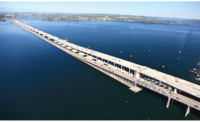 Jacob Myer
Jacob Myer
San Jose, Calif.
ENR Northwest 8/8-15/16 p. NW22
Design engineer gets technical with post-tensioning during demolition of a floating bridge in Seattle.
For decades, the 7,580-ft-long concrete pontoon bridge, connecting Seattle to points east on Lake Washington, served as the longest floating bridge in the world. But following the April 2016 opening of a brand-new version just a few feet to the north, what was once a landmark was now in the way.
And moving it wasn’t going to prove an easy task.
Pulling apart 31 pontoons for reuse all over the world posed a challenge due to external post-tensioning that ran the length of the bridge. Early scenarios all resulted in the same potential risk: catastrophic failure, as the 24 ft of stored energy in the post-tensioned tendons could snap, sinking the pontoons.
Jacob Myer, then a design engineer and now a chief engineer for Schwager Davis Inc., was brought in to devise a solution without the risk of releasing energy that could set off a chain reaction.
Detensioning a 3,600-ft grouted tendon had never before been done, he says. He created a procedure to disassemble systematically each tendon under load, a process that started by removing the HDPE pipe and chipping off the grout. Next, the individual strands had to be cut under load and re-anchored. “Finally, 24 feet of elongation could be slowly released,” he says. “If any of these steps failed, it would have likely resulted in worker fatalities and potential sinking of the pontoon bridge. We had little room to learn or adjust on site, as every step needed to function properly from the first cut.”
Before hitting the water with a live demo, Myer ran tests in controlled environments. To account for the dangerous variables in the existing structure, he designed a strand-anchoring yoke to transfer force.
Safety was a major factor, not only because of the project’s tight tendon spacing, making for tricky maneuvering for personnel, but also because the bridge was floating next to a brand-new, multibillion-dollar project. “Safely accounting for the variables posed by the old strand and its environment was the key challenge to meet in design,” he says. “Ignoring those variables or making best-case scenario assumptions could quickly lead to injury, fatalities and pontoon sinking.”
With Schwager Davis since 2008, Myer notes that, since the technical application remains the most complicated of his career thus far, the “fact that it was such a success definitely made it one of my most rewarding projects.”
Dave Becher, Washington State Dept. of Transportation SR 520 director of construction, says Myer and the Schwager Davis team were a significant part of the bridge decommissioning.
“Jacob and his team’s post-tensioning knowledge and experience helped to guide a complex situation and make it safe and manageable,” Becher adds.
The project crew was most concerned about grout segregation, a likely occurrence with the simple cement-and-water mix on a tendon of this length, not to mention injection pressure as high as it was when originally installed. If the grout in the tendon was in questionable condition, there may not have been sufficient strength to hold each individual strand’s force during re-anchoring. To account for the potential problem, Schwager Davis designed a strand-anchoring yoke to transfer the force of the pontoon until re-anchoring was complete.
“The keys to success on the S.R. 520 detensioning project were careful planning and full-scale testing, acknowledging the sensitive nature of the work,” Myer says. “Foreseeing the potential tendon deficiencies—and building our procedures to account for them—resulted in tendon detensioning completed injury-free, ahead of schedule and with all floating pontoons functional and intact.”






